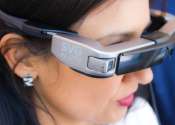Amazon tightens police access to Ring camera video
Amazon on Wednesday said it will stop letting police directly ask people for video from the company's Ring doorbell or home security cameras.
Jan 24, 2024
0
1
Business

Amazon on Wednesday said it will stop letting police directly ask people for video from the company's Ring doorbell or home security cameras.
Jan 24, 2024
0
1
Hardware

Have you ever wondered what wildlife animals do all day? Documentaries offer a glimpse into their lives, but animals under the watchful eye do not do anything interesting. The true essence of their behaviors remains elusive. ...
Jan 18, 2024
0
12
Computer Sciences

When is an apple not an apple? If you're a computer, the answer is when it's been cut in half.
Oct 11, 2023
0
1
Security

With video calls becoming more common in the age of remote and hybrid workplaces, "mute yourself" and "I think you're muted" have become part of our everyday vocabularies. But it turns out muting yourself might not be as ...
Sep 25, 2023
2
315
Machine learning & AI

A research team consisting of scientists from St Petersburg University, St Petersburg Federal Research Center of the Russian Academy of Sciences and some other organizations have created a database of eye movement strategies ...
Sep 4, 2023
0
17
Consumer & Gadgets

Someone wearing augmented reality (AR) or "smart" glasses could be Googling your face, turning you into a cat or recording your conversation—and that creates a major power imbalance, said Cornell researchers.
Aug 28, 2023
6
300
Hi Tech & Innovation

Vision depends on light entering the eyes through the transparent tissues of the cornea, pupil and lens. When the light reaches the retina, photoreceptors produce signals and transmit them via the optical nerve to the brain, ...
Other

The journey to the ocean floor to reach the wreck of the Titanic is one that gets relentlessly colder and darker, says one of the handful of people who have ever visited the luxury liner's watery grave.
Jun 22, 2023
0
10
Internet

Fifteen years after its launch, a Google Maps feature that lets people explore faraway places as though standing right there is providing a glimpse of the metaverse being heralded as the future of the internet.
Sep 2, 2022
0
156
Telecom

An agreement signed yesterday looks to extend the use of ESA space technology along European roads. The Agency's Navigation Directorate has finalized a Memorandum of Intent with ERTICO, the organization for the European Road ...
Aug 24, 2022
0
16
A video camera is a camera used for electronic motion picture acquisition, initially developed by the television industry but now common in other applications as well. The earliest video cameras were those of John Logie Baird, based on the electromechanical Nipkow disk and used by the BBC in experimental broadcasts through the 1930s. All-electronic designs based on the cathode ray tube, such as Vladimir Zworykin's Iconoscope and Philo T. Farnsworth's Image dissector, supplanted the Baird system by the 1940s and remained in wide use until the 1980s, when cameras based on solid-state image sensors such as CCDs (and later CMOS active pixel sensors) eliminated common problems with tube technologies such as burn-in and made digital video workflow practical.
Video cameras are used primarily in two modes. The first, characteristic of much early television, is what might be called a live broadcast, where the camera feeds real time images directly to a screen for immediate observation; in addition to live television production, such usage is characteristic of security, military/tactical, and industrial operations where surreptitious or remote viewing is required. The second is to have the images recorded to a storage device for archiving or further processing; for many years, videotape has been the primary format used for this purpose, but optical disc media, hard disk, and flash memory are all increasingly used. Recorded video is used not only in television and film production, but also surveillance and monitoring tasks where unattended recording of a situation is required for later analysis.
Modern video cameras have numerous designs and uses, not all of which resemble the early television cameras.
This text uses material from Wikipedia, licensed under CC BY-SA